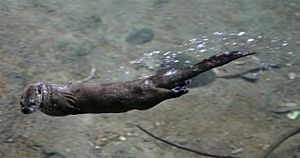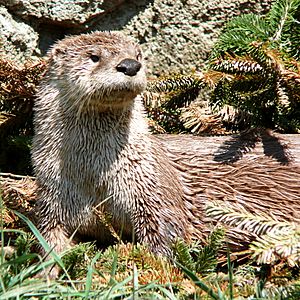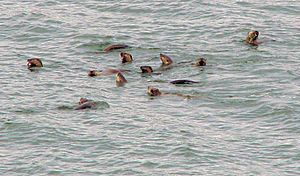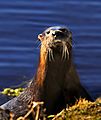North American river otter facts for kids
Quick facts for kids North American river otter |
|
|---|---|
 |
|
| A pair at the San Francisco Zoo in 2005 | |
| Conservation status | |
| Scientific classification | |
| Genus: |
Lontra
|
| Species: |
canadensis
|
| Subspecies | |
|
See text |
|
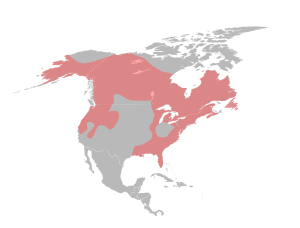 |
|
| Synonyms | |
|
Lutra canadensis |
|
The North American river otter (Lontra canadensis) is a furry mammal that spends its life both in water and on land. It lives only in North America, usually near rivers, lakes, and coasts. These otters are part of the weasel family (Mustelidae). An adult otter can weigh between 5 and 14 kilograms (11 to 31 pounds). Their thick, waterproof fur keeps them warm and dry.
River otters build their homes, called dens or holts, close to the water's edge. These dens often have many tunnels, with at least one opening directly into the water. Female otters give birth to their young, called pups, in these safe burrows. They usually have one to six pups at a time.
North American river otters are skilled hunters. They mostly eat fish, but they also enjoy frogs, salamanders, crayfish, and even small turtles. Sometimes, they might eat small animals like mice or birds. Sadly, their homes are shrinking because of human development and pollution. However, many projects are helping to bring them back to areas where they once lived.
Contents
All About the North American River Otter
The North American river otter is a fascinating animal. It is known by many names, including the northern river otter and simply river otter. These playful creatures are well-adapted to life in and out of the water.
What is a River Otter?
River otters have a special body shape that helps them glide through water easily. They have long, sensitive whiskers that help them find food in dark or murky water. Their eyes are adapted for seeing underwater, which means they are a bit nearsighted on land. They also have a clear inner eyelid that protects their eyes while swimming.
Male otters are usually larger than females. An average adult male weighs about 11.3 kg (25 pounds), while females weigh around 8.3 kg (18 pounds). Their bodies can be 66 to 107 cm (26 to 42 inches) long, with a long, tapered tail adding another 30 to 50 cm (12 to 20 inches). In the wild, North American river otters can live for 8 to 13 years. In zoos, they can live much longer, sometimes up to 25 years!
Otters have strong teeth, including sharp canines for catching prey. They also have large molars that can crush hard shells, like those of clams.
Where Do River Otters Live?
North American river otters live all across North America. You can find them in Canada, the Pacific Northwest, along the Atlantic states, and near the Gulf of Mexico. They also live in Alaska, including the Aleutian Islands.
However, human cities and pollution have caused their numbers to drop in some areas. They are now rare or missing in states like Arizona, Kansas, and Ohio. Good news though! Many projects are working to bring them back. For example, in Kentucky, their population has grown so much that trapping seasons have started again. In San Francisco, an otter nicknamed Sutro Sam was seen in 2012, the first sighting in over 50 years!
Otters need a steady food supply and easy access to water. They are very sensitive to pollution, so they will leave areas where the water is dirty.
What Do River Otters Eat?
North American river otters are active hunters. They mostly eat animals that live in or near water. What they eat depends on what food is easiest to find at different times of the year.
Fish
Fish are the most important part of their diet. Otters usually go for fish that are slower and easier to catch, like suckers, catfish, and sunfish. They can eat about 1 to 1.5 kilograms (2 to 3 pounds) of fish each day! Otters often take larger fish onto land to eat, while smaller fish are eaten in the water.
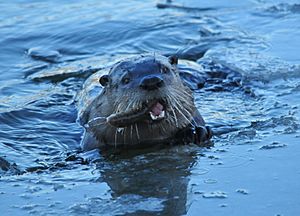
Crustaceans
Crayfish and crabs are also a big part of their diet, especially when they are easy to find. In some places, crayfish make up almost all of the otter's diet during certain times of the year.
Reptiles and Amphibians
Otters also eat frogs and salamanders, especially in spring and summer when these animals are more active. They might also eat small snakes.
Birds
Sometimes, otters will prey on waterfowl like ducks, especially when the birds are molting (losing feathers) and cannot fly easily.
Insects
Water insects are also part of their diet, especially in the summer. Otters might eat insects directly, or they might eat fish that have already eaten the insects.
Mammals
Otters rarely eat mammals. When they do, it's usually small ones like muskrats or voles that live near the water. While some people think otters hunt beavers, most studies show this is not common, and they might only catch young beaver kits.
How Do River Otters Behave?
North American river otters are known for being playful animals. They love to wrestle and chase each other. Playing helps young otters learn important survival skills, like how to fight and hunt.
Otters can live alone, but they are also social animals. They often form groups, especially families. Playing together helps them create strong bonds. They also mark their territory with scents to let other otters know they are around, but they are not usually aggressive about their space. An otter's territory can be quite large, sometimes up to 78 square kilometers (30 square miles).
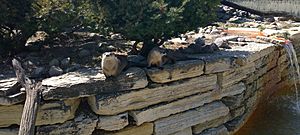
Reproduction and Life Cycle
Female otters look for a safe den in early spring to give birth. They usually don't dig their own dens. Instead, they use burrows made by other animals, like beavers, or natural hollows under logs or in river banks. They line their dens with leaves, grass, and hair to make them cozy.
A mother otter gives birth to one to five pups, with three being a common number. Each newborn pup weighs about 140 grams (five ounces). The mother raises her young by herself. When the pups are about two months old and their fur has grown in, their mother teaches them how to swim. Otters are natural swimmers and learn quickly with their mother's help.
The young otters might leave the den when they are about eight weeks old. They can find their own food by the fall, but they often stay with their family, sometimes even with their father, until the next spring. Before the next litter of pups arrives, the older young otters will go off to find their own homes.
Different Types of Otters
The North American river otter was first described by a German naturalist named Johann Christian Daniel von Schreber in 1777. It was first put into the genus Lutra, but now it is in the genus Lontra, which includes all the river otters found in the Americas.
Scientists believe that the North American river otter and the giant otter of South America separated into different species millions of years ago. Otters from the "Old World" (Europe and Asia) likely crossed a land bridge into North America a long time ago.
There are several different types, or subspecies, of the North American river otter. These are:
- L. c. canadensis (found in eastern Canada, U.S., Newfoundland)
- L. c. kodiacensis (found on Kodiak Island, Alaska)
- L. c. lataxina (found in the U.S.)
- L. c. mira (found in Alaska, British Columbia)
- L. c. pacifica (found in Alaska, Canada, northern U.S., south to central California, northern Nevada, and northeastern Utah)
- L. c. periclyzomae (found on Queen Charlotte Islands, British Columbia)
- L. c. sonora (found in the U.S., Mexico)
Threats to River Otters
River otters face several dangers. In some cold northern areas, they can be hunted by large predators like grizzly bears and polar bears.
The biggest threats to otters come from human activities.
- Habitat Loss: When wetlands are filled in or natural areas are developed for cities and industries, otters lose their homes.
- Pollution: Oil spills are very dangerous for otters, especially in coastal areas. Dirty water from pollution, like acid drainage from coal mines, can kill the fish and other animals otters eat, making it impossible for them to live there.
- Trapping: In some areas, otters are still trapped for their fur. While current trapping rules usually don't threaten the whole otter population, they can slow down how quickly otter numbers grow in certain places.
Since the 1970s, many efforts have been made to protect and bring back otter populations. Over 4,000 otters have been moved and released into 21 U.S. states to help them recover. These efforts, along with cleaner water laws, have helped otters return to many parts of their old homes.
Conservation Status
The North American river otter is currently listed as a species of "least concern" by the IUCN Red List. This means they are not in immediate danger of extinction. They are also listed in Appendix II of CITES (Convention on International Trade in Endangered Species of Wild Fauna and Flora). This means that while they are not currently threatened, their trade is carefully watched to make sure their numbers stay healthy.
While otters have made a great comeback in many areas, they are still rare or missing in parts of the southwestern United States. Keeping our waters clean and protecting their habitats are very important for their future.
Images for kids
-
A North American river otter in the San Anselmo Creek
See also
 In Spanish: Lontra canadensis para niños
In Spanish: Lontra canadensis para niños




